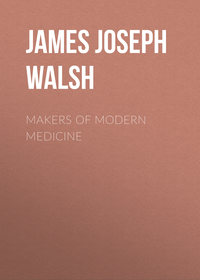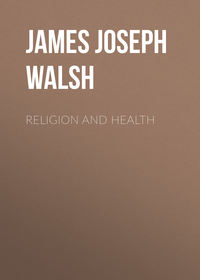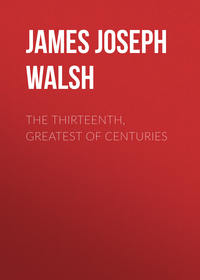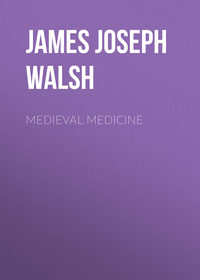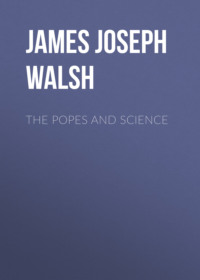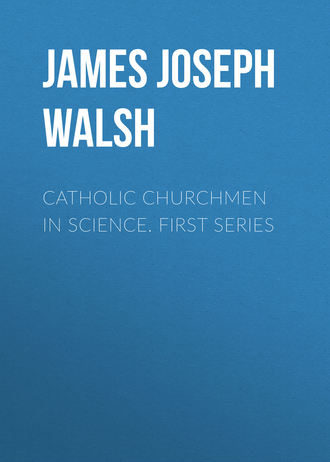 полная версия
полная версияCatholic Churchmen in Science. First Series
The ideas of Nicholas of Cusa with regard to knowledge and the liberty of judgment in things not matters of faith can be very well appreciated from some of his expressions. "To know and to think," he says in one passage, "to see the truth with the eye of the mind is always a joy. The older a man grows, the greater is the pleasure it affords him; and the more he devotes himself to the search after truth, the stronger grows his desire of possessing it. As love is the life of the heart, so is the endeavor after knowledge and truth the life of the mind. In the midst of the movements of time, of the daily work of life, of its perplexities and contradictions, we should lift our gaze fearlessly to the clear vault of heaven and seek ever to obtain a firmer grasp of, and keener insight into, the origin of all goodness and duty, the capacities of our own hearts and minds, the intellectual fruits of mankind throughout the centuries, and the wondrous works of nature around us; but ever remembering that in humility alone lies true greatness, and that knowledge and wisdom are alone profitable in so far as our lives are governed by them."1 It is no wonder, then, that the time was ripe for Copernicus and his great work in astronomy, nor that that work should be accomplished while he was a canon of a cathedral and for a time the vicar-general of a diocese.
It is now nearly five years since Father Adolph Muller, S.J., professor of Astronomy in the Pontifical Gregorian University of Rome, and director of a private observatory on the Janiculum in that city, wrote his historical scientific study2 of the great founder of modern astronomy. The book has been reviewed, criticized and discussed very thoroughly since then, and has been translated into several languages. The latest translation was into Italian, the work of Father Pietro Mezzetti, S.J.,*3 and was published in Rome at the end of 1902–having had the benefit of the author's revision. The historical details, then, of Copernicus's life may be considered to have been cast into definite shape, and his career may be appreciated with confidence as to the absolute accuracy and essential significance of all its features.
Nicholas Copernicus–to give him the Latin and more usual form of his name–was the youngest of four children of Niclas Copernigk, who removed from Cracow in Poland to Thorn in East Prussia (though then a city of Poland), where he married Barbara Watzelrode, a daughter of one of the oldest and wealthiest families of the province. His mother's brother, after having been a canon for many years in the cathedral of Frauenburg, was elected Bishop of the Province of Ermland. The future astronomer was born in 1473, at a time when Thorn, after having been for over two hundred years under the rule of the Teutonic Knights, had for some seven years been under the dominion of the King of Poland. There were two boys and two girls in the family; and their fervent Catholicity can be judged from the fact that all of them, parents and children, were inscribed among the members of the Third Order of St. Dominic. Barbara, the older sister, became a religious in the Cistercian Convent of Kulm, of which her aunt Catherine was abbess, and of which later on she herself became abbess. Andrew, the oldest son, became a priest; and Nicholas, the subject of this sketch, at least assumed, as we shall see, all the obligations of the ecclesiastical life, though it is not certain that he received the major religious orders.
Copernicus's collegiate education was obtained at the University of Cracow, at that time one of the most important seats of learning in Europe. The five-hundredth anniversary of the founding of this University was celebrated with great pomp only a few years ago. Its origin, however, dates back to the times of Casimir the Great, at the end of the thirteenth or the beginning of the fourteenth century. Its foundation was due to the same spirit of enthusiastic devotion to letters that gave us all the other great universities of the thirteenth century. The original institution was so much improved by Jagello, King of Poland, at the beginning of the fifteenth century, that it bears his name and is known as the Jagellonian University. It was very natural for Copernicus to go back to his father's native city for his education; but his ambitious spirit was not content with the opportunities afforded there. He does not seem to have taken his academic degrees, and the tradition that he received his doctorate in medicine at the University of Cracow cannot be substantiated by any documentary evidence.
At Cracow, Copernicus devoted himself mainly to classical studies, though his interest in astronomy seems to have been awakened there. In fact, it is said that his desire to be able to read Ptolemy's astronomy in the original Greek, and to obtain a good copy of it, led him to look to Italy for his further education. During his years at Cracow, however, he seems to have made numerous observations in astronomy, as most of the astronomical data in his books are found reduced to the meridian of Cracow. The observatory of Frauenburg, at which his work in astronomy in later life was carried on, was on the same meridian; so that it is difficult to say, as have some of his biographers, that, since Cracow was the capital of his native country, motives of patriotism influenced him to continue his observations according to this same meridian. Copernicus was anxious, no doubt, to come in contact with some of the great astronomers at the universities of Italy, whom he knew by reputation and whose work was attracting attention all over Europe at that time.
How faithfully Copernicus applied himself to his classical studies can be best appreciated from some Latin poems written by him during his student days. These poems are an index, too, of the personal character of the man, and give some interesting hints of the religious side of his character. Altogether there are seven Latin odes, each ode composed of seven strophes. The seven odes are united by a certain community of interest or succession of subjects. All of them refer to the history of the Redeemer either in types or in reality. In the first one the prophets prefigure the appearance of the Saviour; in the second the patriarchs sigh for His coming; the third depicts the scene of the Nativity in the Cave of Bethlehem; the fourth is concerned with the Circumcision and the imposition of the Name chosen by the Holy Ghost; the fifth treats of the Star and the Magi and their guidance to the Manger; the sixth concerns the presentation in the Temple; and the seventh, the scene in which Jesus at the age of twelve disputes with the doctors in the Temple at Jerusalem.
Copernicus's recent biographers have called attention particularly to the poetical beauties with which he surrounds every mention of the Blessed Virgin and her qualities. As is evident even from our brief resume of the subjects of the odes, the themes selected are just those in which the special devotion of the writer to the Mother of the Saviour could be very well brought out. There are, besides, a number of astronomical allusions which stamp the poems as the work of Copernicus, and which have been sufficient to defend their authenticity against the attacks made by certain critics, who tried to point out how different was the style from that of Copernicus's later years in his scientific writings. The tradition of authorship is, however, too well established on other grounds to be disturbed by criticism of this sort. The poems were dedicated to the Pope. In writing poetry Copernicus was only doing what Tycho Brahe and Kepler, his great successors in astronomy, did after him; and the argument with regard to the difference of style in the two kinds of writings would hold also as regards these authors.
Copernicus's years as a boy and man–that is, up to the age of thirty-five–corresponded with a time of great intellectual activity in Europe. This fact is not as generally recognized as it should be, for intellectual activity is supposed to have awakened after the so-called Reformation. During the years from 1472 to 1506, however, there were founded in Germany alone no less than six universities: those of Ingolstadt, Treves, Tubingen, Mentz, Wittenberg, and Frankfort-on-the-Oder. These were not by any means the first great institutions of learning that arose in Germany. The universities of Prague and Vienna were more than a century old, and, with Heidelberg, Cologne, Erfurt, Leipsic, and Rostock, besides Greifswald and Freiburg, founded about the middle of the fifteenth century, had reached a high state of development, and contained larger numbers of students, with few exceptions, than these same institutions have ever had down to our own day. In most cases their charters were derived from the pope; and most of the universities were actually recognized as ecclesiastical institutions, in the sense that their officials held ecclesiastical authority.
At this time–the end of the fifteenth and the beginning of the sixteenth century–it was not unusual for students, in their enthusiasm for learning, to attempt to exhaust nearly the whole round of university studies. Medicine seems to have been a favorite subject with scholars who were widely interested in knowledge for its own sake. Almost at the same time that Copernicus was studying in Italy, the distinguished English Greek scholar, Linacre, was also engaged in what would now be called post-graduate work at various Italian universities, and in the household of Lorenzo the Magnificent at Florence, with whose son–so much did Lorenzo think of him–he was allowed to study Greek. Linacre (as will be seen more at length in the sketch of his life in this volume), besides being the greatest Greek scholar of his time, the friend later of More and Colet and Erasmus in London, was also the greatest physician in England.
To those familiar with the times, it may be a source of surprise to think of Copernicus, interested as we know him to have been in literature and devoted so cordially to astronomy, yet taking up medicine as a profession. He seems, however, to have been led to do so by his distinguished teacher, Novara, who realized the talent of his Polish pupil for mathematics and astronomy and yet felt that he should have some profession in life. A century ago Coleridge, the English writer, said that a literary man should have some other occupation. Oliver Wendell Holmes improved upon this by adding: "And, as far as possible, he should confine himself to the other occupation." Novara seems to have realized that Copernicus might be under the necessity of knowing how to do something else besides making astronomical observations, in order to gain his living; and as medicine was satisfyingly scientific, the old teacher suggested his taking it up as a profession. Copernicus made his medical studies in Ferrara and Padua, and obtained his doctorate with honors from Ferrara.
Copernicus seems to have taken up the practice of his profession seriously, and to have persevered in it to the end of his life. His biographers say that in the exercise of his professional duties he was animated by the spirit of a person who had devoted himself to the ecclesiastical life. While he did not publicly practise his profession, he was ever ready to assist the poor; and he also acquired great reputation in the surrounding country for his medical attendance upon clerics of all ranks. This continued to be the case, notwithstanding the fact that after the death of his uncle his mother inherited considerable wealth, and the family circumstances changed so much that he might well have given up any labors that were meant only to add to his income. In a word, he seems to have had a sincere interest in his professional work, and to have continued its exercise because of the opportunities it afforded for the satisfaction of a mind devoted to scientific research.
Copernicus acquired considerable reputation by his medical services. His friend Giese speaks of him as a very skilful physician, and even calls him a second AEsculapius. Maurice Ferber, who became Bishop of Ermland in 1523, suffered from a severe chronic illness that began about 1529. He obtained permission from the canons of the cathedral to have Doctor Copernicus, whose ability and zeal he never ceased to praise, to come from the cathedral town where he ordinarily resided to Heilsburg, in order to have him near him. Bishop Ferber's successor, Dantisco, also secured Copernicus's aid in a severe illness, and declared that his restoration to health was mainly due to the efforts of his learned physician. Giese was so confident of the Doctor's skill that when he became Bishop of Kulm and on one of his episcopal visitations fell ill at a considerable distance from Copernicus's place of residence, he insisted on having the astronomer doctor brought to take care of him.
In 1541 Duke Albert of Prussia became very much worried over the illness of one of his most trusted counsellors. In his distress he had recourse to Copernicus, and his letter asking the Canon of the Cathedral of Frauenburg to come to attend the patient is still extant. He says that the cure of the illness is "very much at his heart"; and, as every other means has failed, he hopes Copernicus will do what he can for the assistance of his faithful and valued counsellor. Copernicus yielded to the request, and the counsellor began to improve shortly after his arrival. At the end of some weeks the Duke wrote again to the canons of the cathedral asking that the leave of absence granted to Copernicus should be extended in order to enable him to complete the cure which had been so happily begun. In this second letter the Duke talks of Copernicus as a most skilful and learned physician. At the end of the month there is a third letter from the Duke, in which he thanks all the canons of the cathedral for their goodness in having granted the desired permission, and he adds that he shall ever feel under obligations "for the assistance rendered by that very worthy and excellent physician, Nicholas Copernicus, a doctor who is deserving of all honor." Not long afterward, when Copernicus's book on astronomy was published, a copy of it was sent to the Duke, and he replied that he was deeply grateful for it, and that he should always preserve it as a souvenir of the most learned and gentlest of men.
There are a number of notes on the art of medicine made by Copernicus in the books of the cathedral library at Frauenburg. They serve to show how faithful a student he was, and to a certain extent give an idea of the independent habit of mind which he brought to the investigation of medicine as well as to the study of astronomy. Unfortunately, these have not as yet found an editor; but it is to be hoped that we shall soon know more of the medical thinking of a man over whose mind tradition, in the unworthier sense of that word, exercised so little influence.
In 1530 Copernicus wrote a short prelude to the longer work on astronomy which he was to publish later. The propositions contained in this work show how far he had advanced on the road to his ultimate discovery. After a few words of introduction, the following seven axioms are laid down:–
1. The celestial spheres and their orbits have not a single center.
2. The center of the earth is not the center of the universe, but only the center of gravity and of the moon's orbit.
3. The planes of the orbits lie around the sun, which may be considered as the center of the universe.
4. The distance from the earth to the sun compared with that from the earth to the fixed stars is extremely small.
5. The daily motion of the heavenly sphere is apparent that is, it is an effect of the rotary motion of the earth upon it axis.
6. The apparent motions of the moon and of the sun are so different because of the effect produced by the motion of the earth.
7. The movements of the earth account for the apparent retrograde motion and other irregularities of the movements of the planets. It is enough to assume that the earth alone moves, in order to explain all the other movements observed in the heavens.
It is no wonder that one of his bishop-friends, Frisio, writing to another bishop-friend, Dantisco, said: "If Copernicus succeeds in demonstrating the truth of his thesis–and we may well consider that he will from this prelude–he will give us a new heaven and a new earth." This shorter exposition of Copernicus's views was found in manuscript in the imperial library in Vienna only about a quarter of a century ago. It is mentioned by Tycho Brahe in one of his works on astronomy in which he reviews the various contemporary advances made in the knowledge of the heavens.
The publication of Copernicus's great work, "De Revolutionibus Orbium Celestium," was delayed until he was advanced in years, because his astronomical opinions were constantly progressing; and, with the patience of true genius, he was not satisfied with anything less than the perfect expression of truth as he saw it. It has sometimes been said that it was delayed because Copernicus feared the storm of religious persecution which he foresaw it would surely arouse. How utterly without foundation is this pretence, which has unfortunately crept into serious history, can be seen from the fact that Pope Paul III accepted the dedication of the work; and of the twelve popes who immediately followed Paul not one even thought of proceeding against Copernicus's work. His teaching was never questioned by any of the Roman Congregations for nearly one hundred years after his death. Galileo's injudicious insistence in his presentation of Copernicus's doctrine, on the novelties of opinion that controverted long-established beliefs, was then responsible for the condemnation by the Congregation of the Index; and, as we shall see, this was not absolute, but only required that certain passages should be corrected. The corrections demanded were unimportant as regards the actual science, and merely insisted that Copernicus's teaching was hypothesis and not yet actual demonstration.
It must not be forgotten, after all, that the reasons advanced by Copernicus for his idea of the movements of the planets were not supported by any absolute demonstration, but only by reasons from analogy. Nearly a hundred years later than his time, even after the first discoveries had been made by the newly constructed telescopes, in Galileo's day, there was no absolute proof of the true system of the heavens. The famous Jesuit astronomer, Father Secchi, says the reasons adduced by Galileo were no real proofs: they were only certain analogies, and by no means excluded the possibility of the contrary propositions with regard to the movements of the heavens being true. "None of the real proofs for the earth's rotation upon its axis were known at the time of Galileo, nor were there direct conclusive arguments for the earth's moving around the sun." Even Galileo himself confessed that he had not any strict demonstration of his views, such as Cardinal Bellarmine requested. He wrote to the Cardinal, "The system seems to be true;" and he gave as a reason that it corresponded to the phenomena.
According to the astronomers of the time, however, the old Ptolemaic system, in the shape in which it was explained by the Danish astronomer Tycho Brahe, who was acknowledged as the greatest of European astronomers, appeared to give quite a satisfactory explanation of the phenomena observed. The English philosopher, Lord Bacon, more than a decade after Galileo's announcement, considered that there were certain phenomena in nature contrary to the Copernican theory, and so he rejected it altogether. This was within a few years of the condemnation by the Congregation at Rome. As pointed out by Father Heinzle, S.J., in his article on Galileo in the "Catholic World" for 1887, "science was so far from determining the question of the truth or falsity of either the Ptolemaic or the Copernican system that shortly before 1633, the year of Galileo's condemnation, a number of savants, such as Fromond in Louvain, Morin in Paris, Berigard in Pisa, Bartolinus in Copenhagen, and Scheiner in Rome, wrote against Copernicanism."
As we have said, Copernicus's book was not condemned unconditionally by the Roman authorities, but only until it should be corrected. This assured protection to the principal part of the work, and the warning issued by the Roman Congregation in the year 1820 particularizes the details that had to be corrected. It is interesting to note that whenever Copernicus is spoken of in this Monitum it is always in flattering terms as a "noble astrologer"–the word astrologer having at that time no unworthy meaning. The whole work is praised and its scientific quality acknowledged.
The passages requiring correction were not many. In the first book, at the beginning of the fifth chapter, Copernicus made the declaration that "the immobility of the earth was not a decided question, but was still open to discussion." In place of these words it was suggested that the following should be inserted: "In order to explain the apparent motions of the celestial bodies, it is a matter of indifference whether we admit that the earth occupies a place in the middle of the heavens or not."
In the eighth chapter of the first book, Copernicus said: "Why, then, this repugnance to concede to our globe its own movement as natural to it as is its spherical form? Why prefer to make the whole heavens revolve around it, with the great danger of disturbance that would result, instead of explaining all these apparent movements of the heavenly bodies by the real rotation of the earth, according to the words of AEneas, 'We are carried from the port, and the land and the cities recede'?" This passage was to be modified as follows: "Why not, then, admit a certain mobility of the earth corresponding to its form, since the whole universe of which we know the bounds is moved, producing appearances which recall to the mind the well-known saying of AEneas in Virgil, 'The land and the cities recede'?"
Toward the end of the same chapter Copernicus, continuing the same train of thought, says: "I do not fear to add that it is incomparably more unreasonable to make the immense vault of the heavens revolve than to admit the revolution of our little terrestrial globe." This passage was to be modified as follows: "In one case as well as in the other–that is, whether we admit the rotation of the earth or that of the heavenly spheres–we encounter the same difficulties."
The ninth chapter of the first book begins with these words: "There being no difficulty in admitting, then, the mobility of the earth, let us proceed to see whether it has one or a number of movements, and whether, therefore, our earth is a simple planet like the other planets." The following words were to be substituted: "Supposing, then, that the earth does move, it is necessary to examine whether this movement is multiple or not."
Toward the middle of the tenth chapter Copernicus declares: "I do not hesitate to defend the proposition that the earth, accompanied by the moon, moves around the sun;" while the wording of this proposition had to be changed so as to substitute the term "admit" for "defend." The title of the eleventh chapter, "Demonstration of the Triple Movement of the Earth," was modified to read as follows: "The Hypothesis of the Triple Movement of the Earth, and the Reasons Therefor." The title of the twentieth chapter of the fourth book originally read: "On the Size of the Three Stars [Sidera], the sun, the moon, and the earth." The word "stars" was removed from this title, the earth not being considered as a star. The concluding words of the tenth chapter of the first book, "So great is the magnificent work of the Omnipotent Artificer," had to be cancelled, because they expressed an assurance of the truth of his system not warranted by knowledge. With these few unimportant changes, any one might read and study Copernicus's work with perfect freedom.
Traditions to the contrary notwithstanding, Galileo, because of the friendship and encouragement of the churchmen in Italy, had been placed in conditions eminently suited for study and investigation. Several popes and a number of prominent ecclesiastics were his constant friends and patrons. The perpetual secretary of the Paris Academy of Sciences, M. Bertrand, himself a great mathematician and historian, declares that the long life of Galileo was one of the most enviable that is recorded in the history of science. "The tale of his misfortunes has confirmed the triumph of the truth for which he suffered. Let us tell the whole truth. This great lesson was learned without any profound sorrow to Galileo; and his long life, considered as a whole, was one of the most serene and enviable in the history of science."





